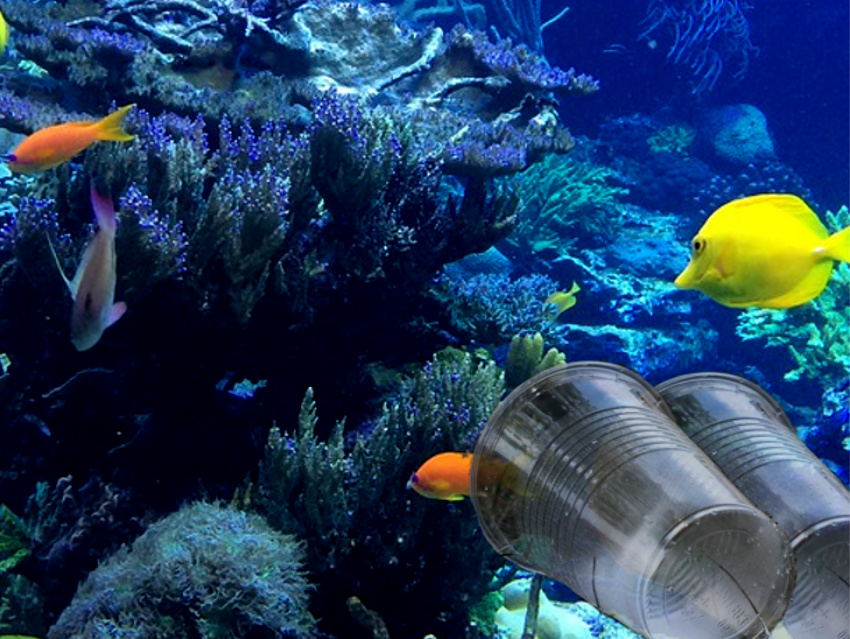What happens to our plastic when it is released into the environment? A team of scientists took a close look at coastal sediments in Southern California, USA, and found that the amount of plastic deposited on the sea floor has increased in parallel to worldwide plastic production over the period since World War II. The rise in microplastic pollution also correlated with population growth in that area [1].
Microplastic Sinks to the Ocean Floor …
Plastic films floating in the ocean are not a pleasant sight, and it is heartbreaking when sea lions and whales are found starving with their stomach full of plastic bags because they mistook someone’s shopping bags for prey. Unfortunately, plastic items floating on the surface are only part of the problem. Larger pieces of plastic break down and release microplastic particles, which sink to the ground where they may enter the benthic food web on the sea floor. As plastic does not degrade naturally, the particles will ultimately become part of the ocean sediments.
Plastic is also seen as one of the markers of the Anthropocene, the newly proposed geological epoch connected with human activity. To test whether plastic entry into ocean sediments can be measured, marine biologist Jennifer A. Brandon from the Scripps Institution of Oceanography at the University of California San Diego, USA, and her colleagues investigated a sediment core from a drilling site in the Santa Barbara Basin, California. This sea floor region is known for its minimal disturbance and excellent preservation of sediment layers. As each layer represents one year of deposition, the scientists could assign the plastic in the layers to the year they were deposited, from 1834 to 2010.
… And Comes to Rest as Sediment
As most of our plastic polymers were only invented in the second half of the 20th century, it would seem unlikely that any plastic particles would be found in earlier deposits. However, Brandon and her team encountered a low but steady number of microplastic particles in layers even down to the earliest year. Assuming that these particles were due to contamination from sampling or sample processing—the sampling equipment was partly made from plastic—the researchers subtracted this amount from the total particle count in each sample and achieved a steady baseline until the year 1945.
After this, the numbers rose, first slowly, then fast, reaching counts of thirty to forty microplastic particles per square decimeter in the 2000s. This exponential growth curve strikingly matched that of worldwide plastic production between 1945 and 2010. The data also correlated with the development of the human coastal population of the Santa Barbara drainage basin area. Thus the microplastics in the sediment might have come from households and factories in the coastal areas, from where they are carried by rivers to the sea.
Particle Types And Forms
The researchers detected particles made from polystyrene, polyamide (nylon), poly(ethylene terephthalate) (PET), poly(vinyl chloride) (PVC), and low- and high-density polyethylene, all characterized by their vibration bands in Fourier-transform infrared (FTIR) spectra. However, identification proved to be challenging because fibrous particles were often too thin to be analyzed in a standard FTIR spectrometer (the scientists suggest using a micro-FTIR for further analyses). Nevertheless, the researchers reported they had identified “at least 10 % of the particles from one-fifth of their sediment layer samples.”
Detecting the plastic particles was also a tedious procedure. The scientists sieved every sample through a 104-micrometer mesh, then they visually inspected the residual matter under a microscope to discern plastic from natural sediment. Fragments could be differentiated from natural matter by their sharp edges, and fibers revealed themselves by their variable lengths and shapes, atypical for residues of biological origin. At least two-thirds of the microplastics—all with sizes between 200 and 600 micrometers—were fibers. The other shapes were fragments of various forms, films, and a very small number of spheres.
Consequences
The study proved once again that plastic microparticles had entered marine sediments and, moreover, their density in the sediment layers reflects the yearly increase in plastic production and consumption, at least at the site of the entry. These findings offer new input into the Anthropocene debate and how the markers of this epoch can be determined. Drilling cores in the sea floor and counting particles is one possible approach, according to the study.
This adds another interesting point of view: In millions of years, when the continental drift has caused new mountains to rise from the ground that once was the sea floor, will Earth’s remaining humans be climbing mountains made of compacted plastic?
- Multidecadal increase in plastic particles in coastal ocean sediments,
Jennifer A. Brandon, William Jones, Mark D. Ohman,
Sci. Adv. 2019.
https://doi.org/10.1126/sciadv.aax0587




